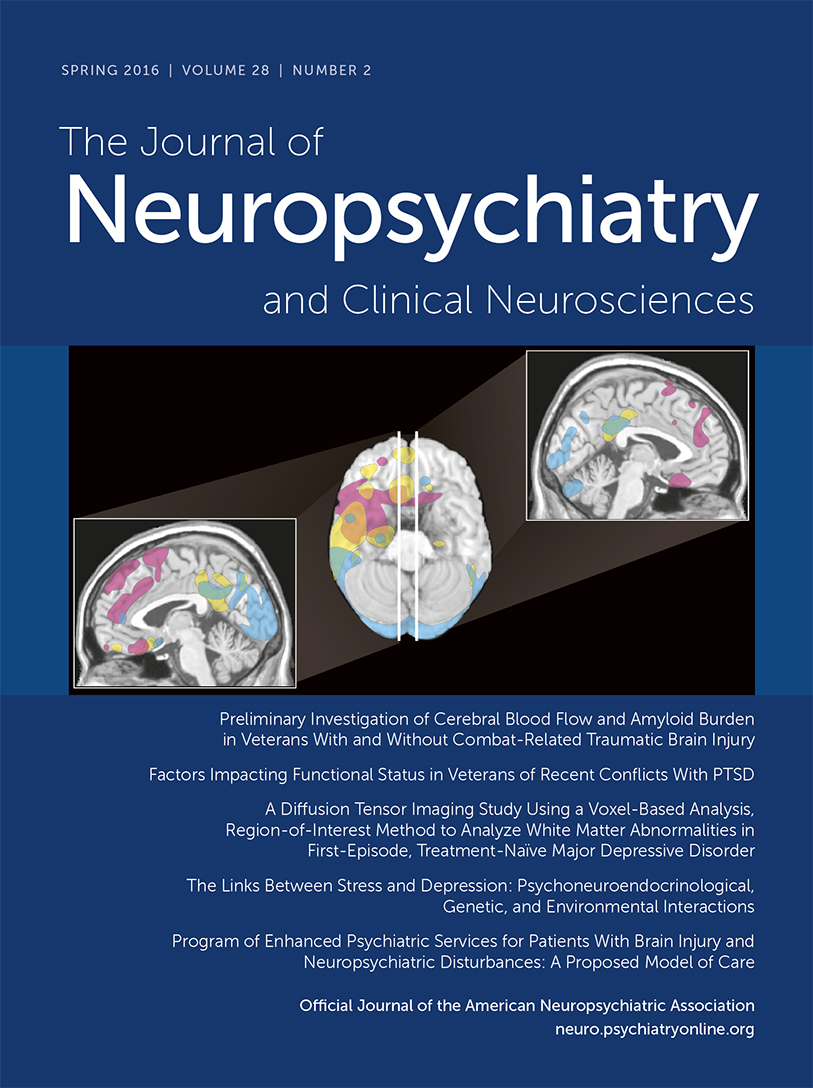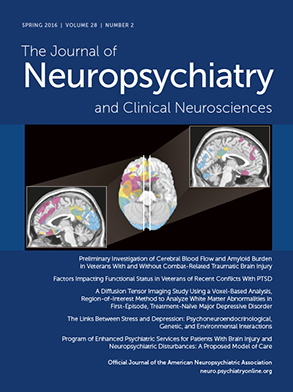Case Report
A 27-year-old man with no past history of psychiatric illness was admitted to the trauma intensive care unit with traumatic brain injury (TBI) consisting of a subdural hematoma, a cerebral contusion of the inferior frontal and bilateral temporal lobes, and a right temporal bone fracture after being involved in a pedestrian-versus-car accident. No neurosurgical intervention was required, but a 3% sodium chloride infusion was utilized from hospital days 1–4 at 30 mL per hour to maintain a goal sodium of >140 mmol/dL. At the time of discontinuation, the patient’s serum sodium level was 141 mmol/dL with a serum osmolality of 299 mOsm/kg.
The patient experienced extreme agitation and hyperactive delirium despite trials of continuous infusions of propofol, fentanyl, and dexmedetomidine while intubated. After extubation on day 3, the patient’s persistent agitation was treated with escalating doses of medications including 10 mg of intravenous haloperidol every 2 hours as needed and quetiapine at doses up to 200 mg every 6 hours.
On hospital day 7, the patient’s serum sodium level, which was previously stable at 140 mmol/L, decreased to 126 mmol/L over 9.5 hours. His serum sodium level reached a nadir at 123 mmol/L on hospital day 8, with a serum osmolality of 271 mOsm/kg. In the 24 hours before the initial decrease in his serum sodium level, the patient received a total of 150 mg of intravenous haloperidol, 650 mg of quetiapine, and 12 mg of intravenous lorazepam, along with dexmedetomidine at 1.5 μg/kg per minute for 18 hours.
By hospital day 8, the patient was 7.2 L positive with adequate urinary output. He remained hemodynamically stable, and his serum creatinine and blood urea nitrogen levels were within normal limits during hospitalization. A spot urine sodium level obtained on hospital day 8 was 147 mmol/L, which was associated with an elevated urine osmolality of 929 mOsm/kg.
The patient’s overall clinical picture was thought to be consistent with SIADH. As a result, haloperidol and quetiapine were discontinued on hospital day 8, and agitation was treated with as-needed diazepam. In addition, the patient was placed on a free-water restriction and given three doses of 3,000 mg of sodium chloride orally with a correction of the serum sodium level to 133 mmol/L by day 9.
After the initial rise in the serum sodium level, the patient was transitioned to 20 mg of ziprasidone every 12 hours for persistent delirium and agitation, which did not appear to hinder the resolution of his hyponatremia. Because of persistent delirium, the patient was rechallenged with quetiapine monotherapy on day 15 at a dose of 100 mg every 8 hours, and again the serum sodium level decreased from 134 mmol/L to 127 mmol/L. This was treated with the addition of 2,000 mg of sodium chloride orally every 12 hours and free-water restriction, which normalized his serum sodium level the same day.
Discussion
We describe a patient with refractory hyperactive delirium after TBI with probable SIADH induced by antipsychotic medications, specifically haloperidol and quetiapine, but not ziprasidone. Removal of the two agents resulted in reversal of the hyponatremia, but rechallenge with quetiapine caused a similar decrease in serum sodium levels, which subsequently resolved with oral administration of sodium chloride. Use of the Naranjo Adverse Drug Reaction Probability Scale indicates a probable drug reaction to high-dose haloperidol and quetiapine, with a score of 7.
1The mechanism of SIADH likely results from increased antidiuretic hormone secretion from stimulation of central serotonin receptors, as well as increased responsiveness within the kidney causing water reabsorption and dilutional hyponatremia.
2 Psychoactive medications are commonly implicated as causes of SIADH, particularly antidepressants and first-generation antipsychotics. Selective serotonin reuptake inhibitors have a high incidence of inducing hyponatremia, varying from 0.5% to 32%, with the effects seen largely within the first weeks of initiation. Haloperidol, a first-generation antipsychotic agent, has also been associated with SIADH when used as monotherapy.
3,4 Although each atypical antipsychotic has been implicated in causing SIADH, the syndrome appears more commonly when used in combination with other potentially offending agents.
5–9 Rechallenge with a second antipsychotic agent after development and resolution has also been shown to induce a recurrence of SIADH.
7 Quetiapine-induced SIADH, to our knowledge, has only previously been reported in two cases: one with the concomitant use of escitalopram for treatment of depression and agitation, and the other in combination with haloperidol for treatment of paranoid schizophrenia.
5,9Our patient had no prior documented psychiatric illness, a common factor that was seen with previous patients. However, the patient had other potential causes for his hyponatremia. Both cerebral salt wasting (CSW), which can be a direct result of the patient’s TBI, and SIADH are commonly implicated in this population.
10 Overlapping laboratory and clinical findings make the differentiation of SIADH from CSW challenging for the clinician. In patients with SIADH who have adequate water intake, hyponatremia, serum hypo-osmolarity, and urine hyperosmolarity are seen with the maintenance of euvolemia. The distinction between these two syndromes is of great importance. CSW presents with decreased intravascular volume, requiring isotonic volume repletion, whereas SIADH requires fluid restriction, removal of the underlying cause, and judicious (intravenous or oral) administration of salt.
The correlation between the addition, removal, and rechallenge of quetiapine provides strong evidence for antipsychotic-induced SIADH. These findings highlight the need for close monitoring when utilizing quetiapine, alone or in combination with other antipsychotics, particularly at escalated doses.

